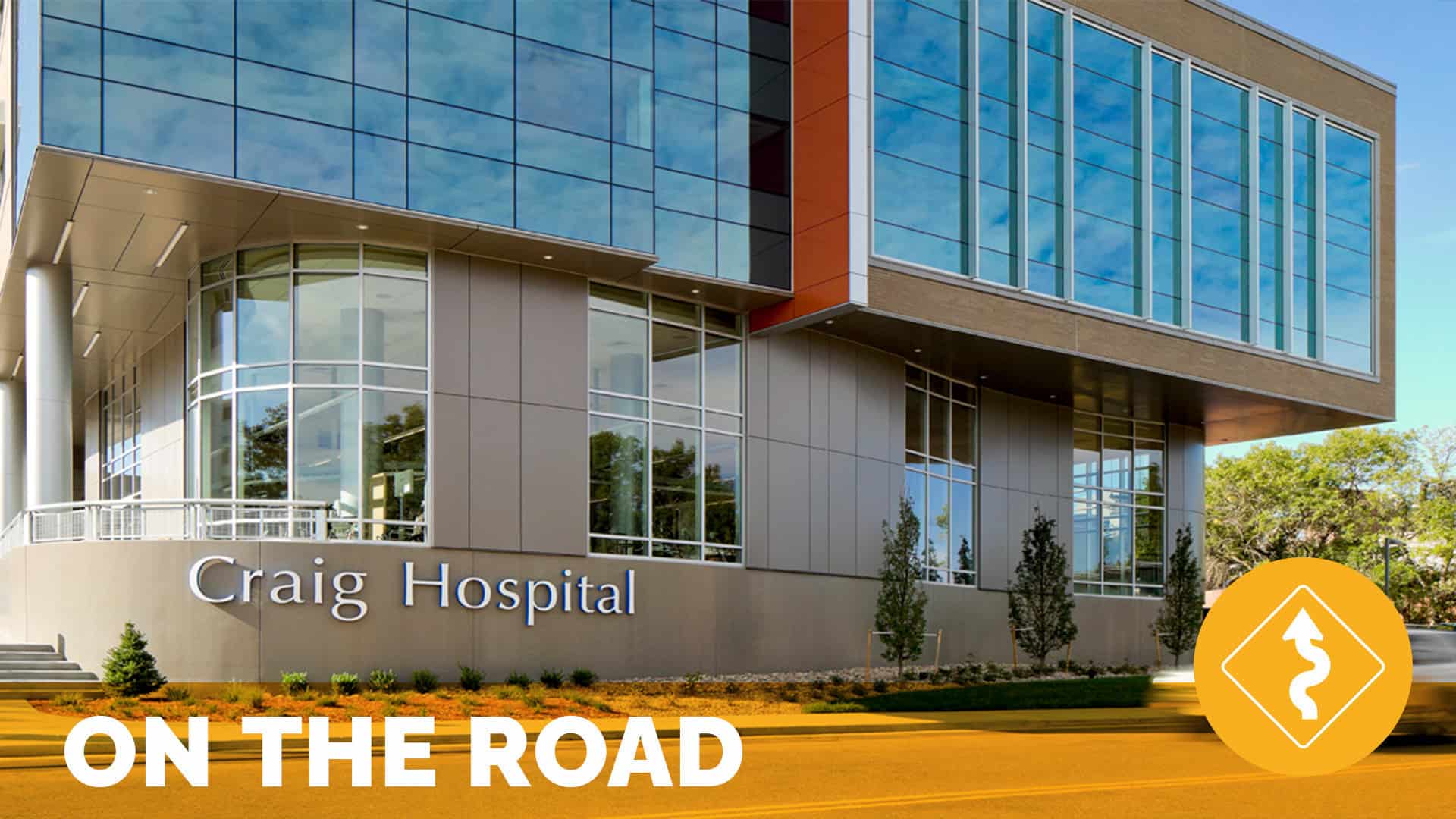Redefining Possible: Lessons from a Specialty Rehab Hospital

On the Road with Craig Hospital – January 2016
by Stacy Palmer
This month’s On the Road highlights the incredible opportunity to learn from organizations that may seem vastly different from your own. I had the privilege to spend time at Craig Hospital, a 93-bed specialty facility near Denver, Colorado. Solely focused on helping people with spinal cord and traumatic brain injuries, Craig is known for embracing patient-centered policies, welcoming family as active participants in the care process and maintaining a culture of empowerment and engagement of staff.
Their patient encounters, with lengths of stay averaging 45-90 days, are very different from those in the acute care setting, allowing them the opportunity to build deeper patient and family relationships. However, they offer many lessons from their patient experience journey that can be replicated in any type of care organization.Diane Reinhard
My host for the visit was Chief Nursing Officer Diane Reinhard, a 26-year veteran at Craig. She explained the primary goals of all team members are to ensure patients are free of harm, receive good care, benefit from their experience and feel safe to go home. The last is especially important at Craig as their patients have all suffered unexpected, traumatic and life-altering situations. Their stays are often bridges from the traditional hospital setting back to a life of independence. “We want to make sure patients are as ready as possible to return home and will be successful there,” said Reinhard.
A Warm Welcome
Since admissions are always planned, Craig has the advantage of anticipating patient arrivals and preparing for a more welcoming first impression. Unit secretaries are among the first team members to greet new patients, as Craig has discovered this builds comfort and confidence by immediately putting a face and name to the voice on the other end of the patient call button. The rest of the care team stops by to introduce themselves within 48 hours of the admission – purposefully staggered as not to overwhelm the patient.
Most patients come to Craig directly from a hospital ICU, so part of the welcome is an introduction to the rehab process and to Craig’s overall philosophy: Although your life has significantly changed, you still can go back into the world and have a good life, and we will show you how.
Work towards the goal of independence starts immediately. Unless a patient is on bed rest, food is not delivered and patients must make their way to the cafeterias for meals. This is important preparation for when they return home but also forces them to be around others. ”When a person has gone through the type of trauma that our patients have experienced and the new disability that resulted, the natural tendency can be to hibernate,” Reinhard said. “But they gain support and knowledge from interacting with each other.”
Also aiding in the transition is the fact that nursing staff wear regular street clothes, not scrubs. Craig has found this helps to neutralize the atmosphere. Since patients have consented to treatment and need to participate in their care, it can be easier when the relationship is neutral. “We have no idea what a person has experienced. Every situation and individual is completely unique,” said Reinhard. “We need to respect and understand that and not position ourselves in a place of higher knowledge.”
Each patient and family has a consistent interdisciplinary treatment team that meets initially upon admission for case planning and then weekly throughout the stay. The team includes: the physician, nurses, physical therapist, occupational therapist, patient and family service counselor, therapeutic recreation specialist, psychologist, pharmacist, chaplain, dietitian, and when necessary, speech and language pathologist, neuropsychologist, respiratory therapist and others. The team works with the patient and family to set goals, develop treatment plans, review progress and coordinate services needed at home following discharge.
Encouraging Family Involvement
Family involvement is viewed as extremely important at Craig and families are encouraged to be active participants in the care experience. Craig believes patients that feel encouraged and empowered are more successful. They have no restrictions on visiting hours and families are welcome to attend therapies and be part of the team. Counselors assist families with their adjustment to injury, understanding insurance policies, application for public benefits and discharge planning. Graduates of Craig (how they refer to former patients) and their families consistently credit some of their success to what other patients and families have taught them.
Healing Spaces
It was clear much thought went into the overall design at Craig. Rooms, hallways and common areas are all very spacious, an essential feature since most patients are using wheelchairs and other equipment to navigate the facility. Reinhard shared that during a recent redesign of the rooms, Styrofoam replicas were created so patients could come through in wheelchairs and be sure there was ample room to move.
Each room includes patient lifts to help people navigate from bed to bathroom. Safekeeper beds (if needed), camera monitoring (if needed) and even personal assistants are available as necessary to help keep patients safe. Craig also utilizes interactive patient engagement technology from Innovatient to allow patients to control temperature, lights and television and even adjust their blinds directly from their beds.
A highlight of my tour was Craig’s PEAK Center; PEAK being an acronym for Performance, Endurance, Attitude and Knowledge. Designed similarly to the rehab areas throughout the hospital, PEAK is open to community members with neurological disabilities. Members can purchase punch cards to use the equipment on their own or with the support of a trained therapist. Much of the equipment is unique to Craig and has undergone extensive research is being done in this area to validate its ability to optimize wellness activities, recovery and overall quality of life. Personal training, group exercise, adaptive yoga and aquatic therapy are all available. The center was truly buzzing with activity during my visit and it was easy to see the engagement of staff in addition to the determination of members.
Other ancillary services are available throughout the hospital including physician offices, therapy spaces and even urology services. “While it can sometimes be challenging to find physician consultants willing to come in, our hope is that much of a patent’s care can be delivered within our walls,” explained Reinhard. “It’s so beneficial when it can work and we can avoid the potential setbacks and difficulty often experienced when transporting patients.”
There is clearly intentional focus throughout the facility to best support and engage patients and families, but Reinhard acknowledged that an equally important focus in their success has been engaging staff. Even in their recent remodel she explained, “Changes had to make all the right reasons for patients and families, of course, but also for staff. They participated in many aspect of planning all the way down to where the light switches were positioned. The staff feel like they own this organization.”
An Engaged Staff and Supportive Leadership Team
Reinhard went on to share that staff also own every experience, knowing they are just as accountable as the CEO for making experiences positive and they are empowered to do so. Their basic mantra is simply: always do the right thing for the patient. “We tell our staff as long as you can explain why you made the choice you did, you will be supported. You don’t need to ask permission to do the job we hired you for.”
I asked Reinhard how they managed to create this culture of ownership and empowerment. Her answer was simple, “We were smart enough as leaders to realize our best efforts are to support our staff.”
She acknowledges a great deal of respect for staff stating their work is hard physically and emotionally as patients are not at their best adult behavior when they are at Craig. “There is nothing intuitive about caring for these types of patients, you have to learn it. Buttons are being pushed; often they have no modesty left. They’ll have bad days …and that’s ok.”
Support for staff starts on their very first day of employment as the senior leadership team greets them immediately after they get set-up with HR and IT. The standard orientation is a full year long with three months of classroom training before they ever start working on the floor. For one week per month following their initial training, they come back together for more training and, perhaps more significantly, an opportunity to talk and share with each other about their work experiences. As Reinhard stated, “Each group becomes a safety net for each other.”
In addition to the overall support of clinical staff, she credits the onboarding program for having significant impact on their average staff tenure of 13 years. The nursing department, which historically has had higher turnover than other departments, has increased their success with on boarding by requiring each nursing candidate to participate in a four-hour shadow with a staff member. “We never underestimate the feedback from the team member being shadowed.”
Innovation in Training
New to Craig’s training program is a simulation lab made up of two replica patient rooms connected by a control booth. Each room has a simulation mannequin that can display neurological symptoms as well as physiological ones; they can talk, breathe, cough and even exhibit varying vital signs. Craig currently uses the simulation for staff training in a controlled, non-punitive environment. In addition, they hope to soon use the rooms for family training.
Reinhard cited helping family members cope with seizures as an example of the advantages of such simulation. “Someone will never get used to seeing their loved one have a seizure, but by going through simulation exercises, we might be able to desensitize them to some of the fear and panic,” she explained.
A Passion for Impacting the Lives of Patients
From a patient experience perspective Craig is doing many positive things to create a culture of excellence, engage patients and families and create optimal environments of care. Their patient relationships are certainly different than many found in more standard care environments, but I believe their passion for this work and overall desire to help patients and families get back their lives can be an inspiration for all.
I love a story Reinhard shared about the difference in working at a specialty rehab facility. She said when she began at Craig Hospital 26 years ago a co-worker warned that at some point she would take a trip or vacation to see a patient. She dismissed the notion at the time remembering the clear lines she was taught in school that must exist between a nurse and patient. But she quickly learned that the lines were grayer in this environment and she was moved by how influential her patients became to her personally. She acknowledges her co-worker was right and she’s now taken multiple family trips to visit Craig Graduates.
“You develop friendships. This is such rewarding work,” said Reinhard. “I can’t imagine doing anything else.”
Related content
-
 Culture & Leadership | Infrastructure & Governance | Staff & Provider Engagement
Culture & Leadership | Infrastructure & Governance | Staff & Provider EngagementOwnership at the Frontline: Innovating an Experience Champions Program
Many patient experience teams are small, and it’s hard to do it all. Having an “Experience Champs” program allows us to have multiple hands with one voice influencing all locations. Experience Champs are made up of frontline staff members who are chosen by their leaders as passionate role models. During the last five years, the
Learn more -
 Environment & Hospitality
Environment & HospitalityEnsuring Peace of Mind: 7 Elements All Lost Belongings Policies Should Include
By Gabriel Bolivar, Maui Health and Hope Ursy, Wellstar MCG Health On behalf of the Lost Belongings Workgroup of the Patient Advocacy Community This PX blog is the first of a series to build on the content from “Where Are My Things? Best Practices for Safeguarding Patient Belongings in Hospitals,” a handbook for those managing
Learn more -
 Culture & Leadership
Culture & LeadershipLooking Back to Move Forward: The Next Decade and Beyond for Human Experience
This issue comes out at an important moment for the experience conversation. It was ten years ago from the publication date of this issue on April 30, 2014, that the first issue of Patient Experience Journal (PXJ) was released. PXJ was intended to be a gathering place. A virtual town square for the experience movement where
Learn more
